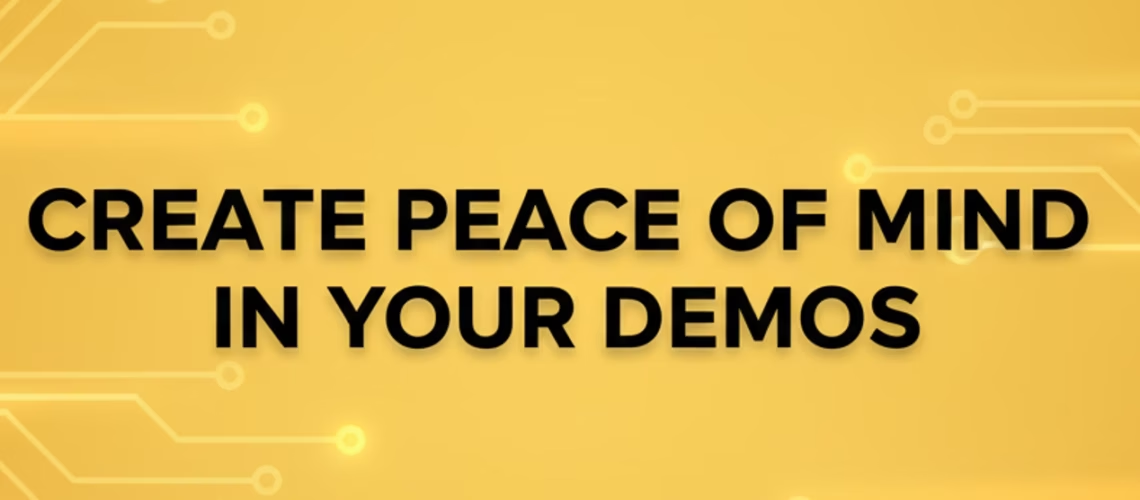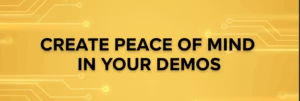Most demos focus on showing what a product can do. Many solution engineers try to impress with features, shortcuts, automations, and deep configuration. It all looks good on paper. But it often does not give the customer what they need most. They want peace of mind.
Peace of mind means your customer walks out of your demo and feels confident. Confident that they can solve their problem. Confident that your product will not make their life harder. Confident that they can reach the outcome they want with as little risk as possible. The demo is the perfect moment to give them this feeling. But most demos fail at exactly that.
Instead of peace of mind, customers often leave a demo with a sense of pressure. The more a demo shows, the more overwhelming it becomes. And the more overwhelming the demo becomes, the higher the perceived risk. Even if the product is strong, the buyer gets stuck in one simple question. “Can we handle this?”
This is the silent fear behind many stalled deals. Buyers do not say it out loud. They simply delay the next meeting. They ask for more information. They want to explore alternatives. They say they need more time. All of this is driven by uncertainty. By a feeling that the solution might work, but could also create new problems for them.
That feeling comes from the way demos are delivered.
Let me give you a picture. You start your demo with a clean screen. The customer is curious. You show one feature. Good. Then the next. Then an advanced menu. Then a settings page. Then a configuration panel. You want to be helpful. You want them to see the range of what is possible. But their mental load grows with every click. Their energy goes into keeping up with you. Not into understanding how they will succeed with your product.
Every extra layer creates friction. And friction means risk. More setup. More training. More dependencies. More things that can break. More people who need to be involved. More potential for something to go wrong. And once the buyer starts thinking about everything that could go wrong, they stop thinking about what could go right.
This is the opposite of peace of mind.
So how can you change this? By shifting the focus of your demo away from what your product can do. And towards what the customer needs in order to feel confident. Confidence is the true outcome of a good demo. Not understanding. Not excitement. Not a list of features. Confidence that they can move from where they are today to where they want to be. Without chaos. Without risk. Without stress.
Here is how you do that.
First, understand the starting point. Every buyer comes into the demo with a set of worries. Some fear complexity. Some fear adoption. Some fear a long rollout. Some fear that they need strong internal support. Some fear they will be stuck with another tool that no one will use. If you do not address these fears, they will carry them out of the room.
Then, understand where they want to go. The end state is not a feature. It is a solved problem. Faster processes. Less work. More visibility. Better insights. A reduction in errors. A clearer way of working. Whatever it is, make it real. Make it tangible. And stay close to it throughout the entire demo.
Third, remove everything that is not essential. A good demo is not a tour. It is not a catalog. It is not a walkthrough of your product’s architecture. It is a story with a clear beginning and a clear ending. Show only what is needed to get the customer from point A to point B. Skip the rest. Less is more. Less noise creates more clarity. And clarity creates peace of mind.
Fourth, make sure the customer feels in control. This is one of the biggest mindset shifts for many SEs. Your goal is not to impress them with how well you navigate the tool. Your goal is to make them feel that they could do it themselves. Show actions that look simple. Use clean examples. Take out any unnecessary steps. Let them see how easy it is to get something done. Ease reduces perceived risk. And perceived risk is the reason deals move slowly.
Fifth, highlight how the solution removes work instead of adding more work. Many buyers are burned out. They sit in too many meetings. They run too many tools. They deal with messy processes. Your demo should give them the feeling that life will get easier with your product. If you can create that feeling, they will trust you.
A good demo is not about you. It is not about showing expertise. It is not about showing how deep your product goes. It is about helping the customer feel safe. Buyers choose vendors that reduce anxiety. Buyers follow teams that make things simple. Buyers invest in solutions that feel low risk.
Peace of mind is the strongest selling point you can offer.
So next time you prepare a demo, ask yourself a simple question. “Will this demo lower or increase the customer’s stress level?” If your demo lowers their stress, you win. If it increases their stress, you have work to do. Your product might be great. But it will not matter if the customer feels overwhelmed.
Keep it simple. Keep it clear. Keep it clean. And help your customer leave the room thinking one thing. “This looks easy. We can do this.”





